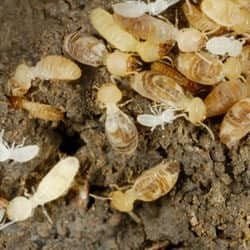There is something refreshing about seeing signs that spring is almost here. Things like more daylight, spring ads on television or in the newspapers and warmer weather apparel making its way into stores, are all hopeful signs of the soon coming season. Immediately your mind goes to yard care, t-shirts, and a glass of iced tea. No matter what kind of a winter we have had, it is safe to say that a lot of us are usually happy to see the end of it for another year. Spring is also a good reminder that with the temperature rising so will the influx of pests. Termites are one such pest that you can be sure will be on the move this spring.
Spring is the time of the year when a termite nest has reached its limit in size and capacity. Swarms of these pests are often spotted making their way through fields and woods, and frequently neighborhoods. Often, we do not really know what we are looking at and will dismiss it from our minds as soon as we are out of sight of it. Unfortunately, these termites might just be looking for a way into your home. If they do get in, these swarmers will quickly establish a nest and get to work on building their population and eating everything in sight all without the homeowner ever knowing they are there.
The termite has a voracious appetite for anything that contains cellulose. Cellulose is found in many things in nature, including building materials that may have been used in your home, like wood. Their extraordinarily strong jaws tirelessly work their way through wood, drywall, paste, glue, and many other materials that can do thousands of dollars in damage to a building undetected until it is visible in the frequented parts of the home.
There is good news though. Homeowners can save thousands in repairs and treatment for termite infestations by working with a reputable pest control company, like Russell’s Pest Control, to prevent termites from entering in the first place. If your home already has termites, we can work with you to eliminate the current threat and set measures in place to prevent future termite damage. Russell’s Pest Control has worked with hundreds of home owners over the years, keeping their most valuable asset termite-free. Imagine the relief knowing that your home is guaranteed to be safe from termites all year-long. That peace of mind is well worth it. Call today to learn more about our quality termite services!
